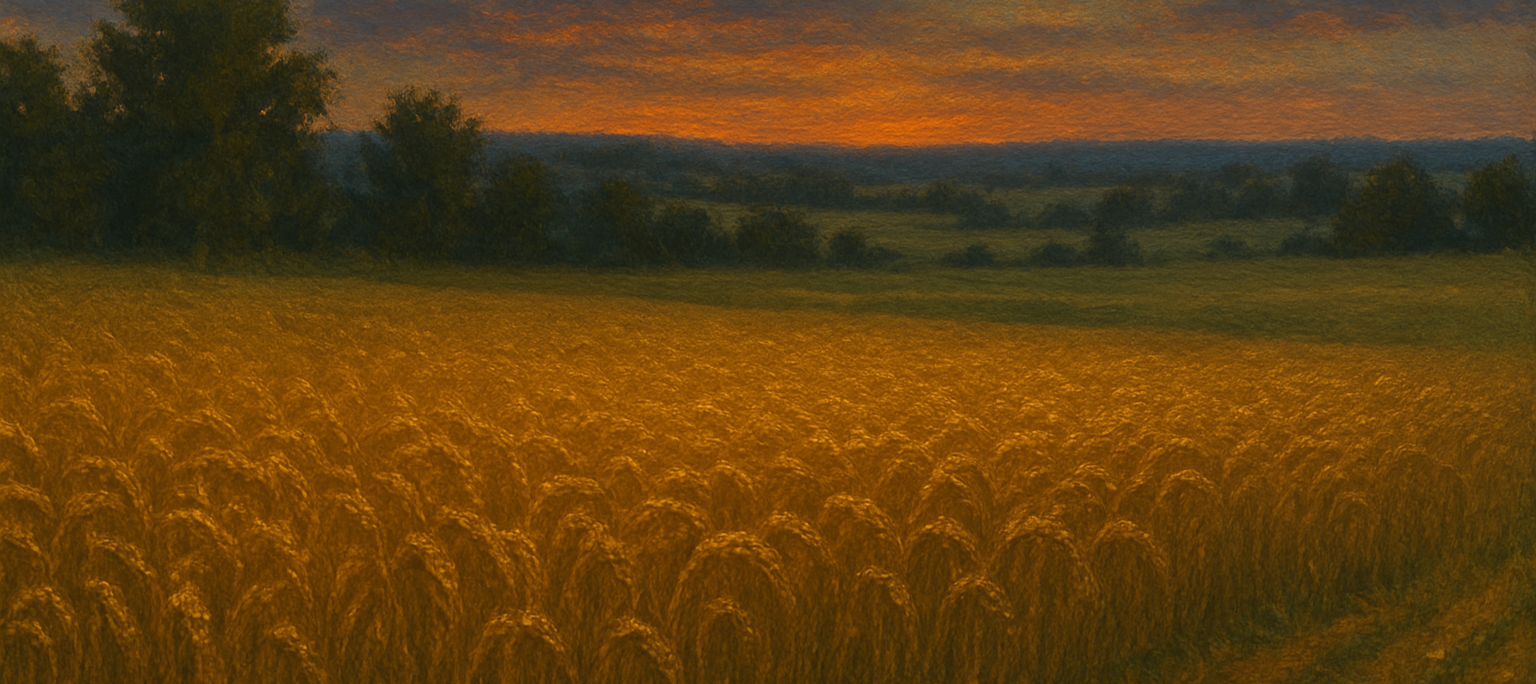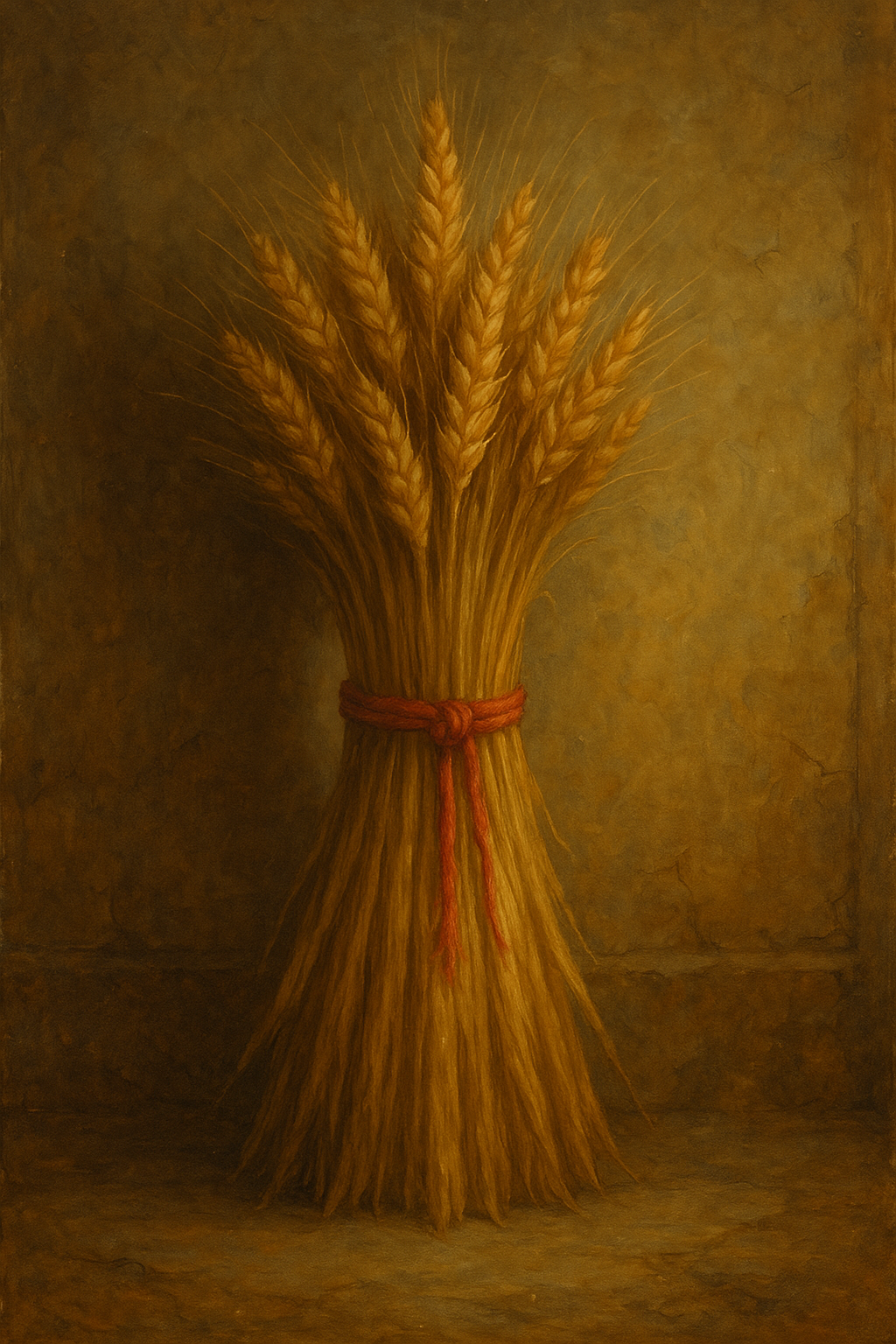Last Sheaf Vigil
The Last Sheaf Vigil is a sacred agricultural rite observed at the end of the harvest season, practiced across much of Tanaria, especially in rural communities that honor Sylvanna or ancestral spirits tied to the land. As the final stalks of grain are cut, the reapers set aside a single sheaf, chosen carefully and bound with red thread or ribbon, symbolizing blood, labor, and life.
Rather than threshing it with the rest, the sheaf is carried with reverence to a home or fieldside shrine and placed upright near the hearth or altar. This final bundle is believed to house the spirit of the field, the essence of growth and fertility that nourished the crop throughout the season. To discard or destroy it carelessly would be to offend the land itself, risking blight, poor soil, or even spiritual misfortune.
The sheaf remains untouched through winter, serving as a quiet guardian over the home or granary. Families often place small offerings, crumbs of bread, dried berries, drops of honey, at its base during Solsday feasts or seasonal festivals. In some regions, it is whispered to hum softly in moonlight or shift slightly during storms, as if restless.
When spring returns and the fields are ready to be tilled, the sheaf is either burned in a ceremonial fire to return its spirit to the land or buried at the edge of the field to “lead” the new planting. If the sheaf is lost, destroyed prematurely, or consumed by pests, it’s taken as a dire omen, some farmers will refuse to plant at all unless a druid or priest intervenes.
The Rite of the Hollow Sheaf
In times of true hardship, when famine, fire, or war leaves the land bare, communities turn to an alternate rite known as the Hollow Sheaf. This is not a substitution taken lightly; it is a mournful ritual, one that acknowledges both the absence of bounty and the death of promise. Instead of grain, a sheaf-shaped effigy is crafted from withered grass, ash-soaked cloth, or straw swept from ruined barns. It’s bound with the same red thread, but loosely, as if ready to fall apart, symbolizing the fragility of survival. Sometimes, if nothing can be found from the land, the effigy is made entirely of woven twine and family keepsakes, hair, threadbare fabric, even bits of broken tools. This Hollow Sheaf is placed at the hearth, just as the true one would be. But it is not burned in spring. It is buried at a crossroads or drowned in a stream, with whispered apologies to the land and prayers for rebirth. Some communities say the land must see your sorrow before it will open itself again. In written records from the War of Ash and Rain, there’s a village where survivors carved the shape of a sheaf into stone and kept it beside their cold hearth for the winter. It became a holy relic, a permanent reminder of the year the land gave nothing, and the people endured anyway.History
The origins of the Last Sheaf Vigil trace back to the early Harmonium Era, in the generations following the Calamity. In that time of rebuilding, farmland was scarce, and superstition walked hand-in-hand with necessity. Survivors believed that each harvest left behind a guardian spirit, one that must not be angered or forgotten. The final sheaf of grain, left standing in the field, was treated as a sacred vessel holding that spirit’s fading strength.
Initially, the rite was simple: the last stalks were left uncut and circled with stones or charms to mark the field’s heart. Families would kneel before it, offering prayers for mercy and survival through the winter. In this form, the ritual was as much an act of desperation as devotion, one last plea to whatever divine forces still watched over the land.
As divine worship stabilized and the influence of Sylvanna, the Verdant Mother, spread, the rite became more formalized. The sheaf was no longer left behind but cut with care, bound with red thread, and brought home to rest near the hearth. This shift reflected a growing sense of partnership between mortals and nature, a transition from fearing the land to honoring it. Sylvanna’s priesthood encouraged this evolution, framing it as a way to “bring the field into the home,” to remind families that life and land were inseparable.
By the middle Harmonium Era, variations of the rite had appeared across the continents. In Kamulos, families crafted elaborate woven sheaf idols, dressing them in scraps of old clothing to symbolize ancestral spirits. In Eouma, the sheaf was buried rather than burned, aligning with their beliefs about reincarnation and harmony with the soil. Some orcish clans of Kalros incorporated the sheaf into blood rites, tying it into their cyclical understanding of survival and sacrifice.
Over time, the practical purpose of the ritual, to symbolize gratitude and continuity, remained, but its tone shifted. In more prosperous eras, it was a hopeful, even joyous tradition. But in times of famine or war, the vigil became somber and fearful. There are recorded instances of households refusing to burn the sheaf, believing the land no longer deserved their offering. In some war-torn regions, sheaves were buried with the dead, representing not the harvest, but what would never be sown again.
Today, while some consider it quaint or outdated, many rural communities still observe the Last Sheaf Vigil. In a world where divine power lingers and the scars of calamity run deep, traditions that honor the balance between labor, land, and loss are never truly forgotten.





Has there ever been an occasion where it was truly impossible to harvest a sheaf? You mentioned things like war and famine and that the Vigil is still carried out, if that's the case, is there an acceptable alternative, or is there tangible object that is permitted in times of true hardship? Either way, during such times, observing the Vigil must make the soul bleed. This is fantastic. The evolution of a any tradition across both time and across regions or the world is a crucial part of understanding and appreciating any tradition and throws everything connected to it into greater relief. Such outstanding work. <3
I really had to think on that one, but that is a great thing I didn't consider. I updated the article to cover those instances and still carry the weight of the ritual itself and its importance. Thanks for bringing that up!
"Every story is a thread, and together we weave worlds."
The Origin of Tanaria